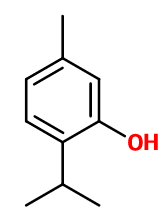
Photo credits: ScenTree SAS
Thymol
5-methyl-2-propan-2-ylphenol ; Apiguard ; Para-cymen-3-ol ; Alpha-cymophenol ; 3-para-cymenol ; 3-hydroxy-para-cymene ; 3- hydroxy-1-methyl-4-isopropylbenzene ; 5-methyl-2-(1-methylethyl)phenol ; 5-methyl-2-isopropyl-1-phenol ; 5-methyl-2-isopropylphenol ; Isopropyl cresol ; 2-isopropyl-5-methylphenol ; Thyme camphor

Photo credits: ScenTree SAS
| Company | Ingredient Name | ID | Comments | Naturality | Certifications | Purity | Latin name | Treated part | Geographical origin | MOQ |
|---|---|---|---|---|---|---|---|---|---|---|
|
|
THYMOL CRYSTALS NF | M_0051351 |
Visit website
|
Synthétique | - | - | - | - | - |
General Presentation
-
CAS N° : 89-83-8
-
EINECS number : 201-944-8
-
FEMA number : 3066
-
FLAVIS number : 04.006
-
JECFA number : 709
-
Appearance : White solid
-
Density : 0,965
-
Volatility : Heart/Base
-
Price Range : €€
Physico-chemical properties
-
Molecular formula : C10H14O
-
Molecular Weight : 150,22 g/mol
-
Log P : 3,3
-
Fusion Point : 50°C
-
Boiling Point : 233°C
-
Detection Threshold : 86 à 790 ppb (0,000079%)
-
Optical rotation : Donnée indisponible
-
Vapor pressure : Donnée indisponible
-
Refractive Index @20°C : Donnée indisponible
-
Acid Value : Donnée indisponible.
-
Flash Point : 101°C
Uses
Uses in perfumery :
Thymol is used in thyme reconstitutions and in aromatic notes.
Year of discovery :
Data not available.
Natural availability :
Thymol is the major constituent of Red Thyme EO and is present in Oregano EO. It can be extracted from these two raw materials.
Isomerism :
Ortho-Thymol, also called Carvacrol, has to be distinguished from para-Thymol, also called para-Cymen-5-ol. Both are Thymol isomers and do not share the same smell. L-Carvone and Dimethyl Benzyl Carbinol are some of the constitutional isomers of Thymol. Their smell is however very different, as it is more minty or floral-fresh.
Synthesis precursor :
Thymol is a precursor to L-Menthol synthesis by catalytic hydrogenation under high temperature and pressure.
Synthesis route :
Thymol is synthesized by an ortho-alkylation process of meta-Cresol with propylene, in the presence of aluminum oxide. This synthesis must be carried out at high pressure and temperature. The reaction is not total, the rest of the reagents are separated from the mixture by a fractional distillation at the end of the reaction.
Regulations & IFRA
Allergens :
This ingredient does not contain any allergen.
IFRA 51th :
This ingredient is not restricted for the 51th amendment


